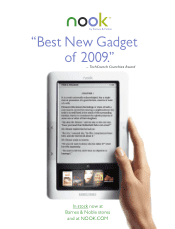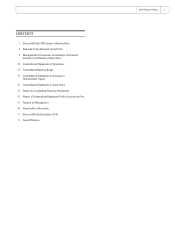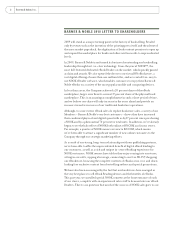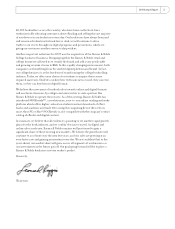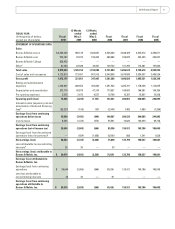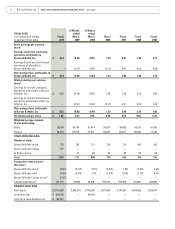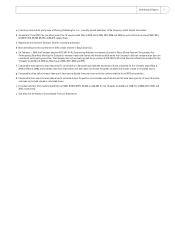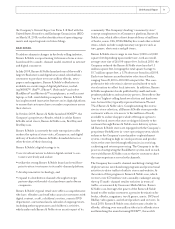Barnes and Noble 2010 Annual Report Download - page 10
Download and view the complete annual report
Please find page 10 of the 2010 Barnes and Noble annual report below. You can navigate through the pages in the report by either clicking on the pages listed below, or by using the keyword search tool below to find specific information within the annual report.
On September 29, 2009, the Board of Directors of Barnes &
Noble, Inc. (Barnes & Noble or the Company) authorized a
change in the Company’s fiscal year end from the Saturday
closest to the last day of January to the Saturday closest
to the last day of April. The change in fiscal year, which
became effective on September 30, 2009 upon the closing
of the acquisition of Barnes & Noble College Booksellers,
Inc. (B&N College) by Barnes & Noble (the Acquisition),
gives the Company and B&N College the same fiscal year.
The change was intended to better align the Company’s
fiscal year with the business cycles of both Barnes & Noble
and B&N College. Accordingly, the Company’s fiscal 2010
year began on May 3, 2009 following a 13 week transition
period ended May 2, 2009. As used in this section, “fiscal
2010” represents the 52 weeks ended May 1, 2010, “transi-
tion period” represents the 13 weeks ended May 2, 2009,
“fiscal 2008” represents the 52 weeks ended January 31,
2009, and “fiscal 2007” represents the 52 weeks ended
February 2, 2008.
GENERAL
Barnes & Noble, the nation’s largest bookseller1, is a
leading content, commerce and technology company that
provides customers easy and convenient access to books,
magazines, newspapers and other content across its
multi-channel distribution platform. As of May 1, 2010, the
Company operated 1,357 bookstores in 50 states, including
637 bookstores on college campuses, and one of the Web’s
largest eCommerce sites, which includes the development
of digital content products and software. Given the dynamic
nature of the book industry, the challenges faced by
traditional booksellers, and the robust innovation pipe-
line fueling new opportunities in hardware, software and
content creation and delivery, Barnes & Noble is utilizing
the strength of its retail footprint to bolster its leadership
and fuel sales growth across multiple channels.
Of the 1,357 bookstores, 720 operate primarily under the
Barnes & Noble Booksellers trade name (eight of which
were opened during fiscal 2010). B&N College, a wholly-
owned subsidiary of Barnes & Noble, operates 637 col-
lege bookstores serving nearly four million students and
faculty members at colleges and universities across the
United States. barnesandnoble.com llc (Barnes & Noble.
Based upon sales reported in trade publications and public filings.
com) encompasses one of the Web’s largest eCommerce
sites, Barnes & Noble eBookstore, Barnes & Noble eReader
software, and the Company’s devices and other hardware
support. Through Sterling Publishing Co., Inc. (Sterling
or Sterling Publishing), the Company is a leading general
trade book publisher. The Company employed approxi-
mately 40,000 full- and part-time employees as of May 1,
2010.
The Company’s principal business is the sale of trade books
(generally hardcover and paperback consumer titles, mass
market paperbacks (such as mystery, romance, science
fiction and other popular fiction), children’s books, eBooks
and other digital content, eReaders and related acces-
sories, bargain books, magazines, gifts, café products and
services, music and movies direct to customers through its
bookstores or on Barnes & Noble.com. Bestsellers (the “top
ten” highest selling hardcover fiction and hardcover non-
fiction) typically represent between 3% and 5% of Barnes &
Noble store sales.
As a result of the Acquisition of B&N College, the Company
sells textbooks and course-related materials, emblematic
apparel and gifts, trade books, school and dorm supplies,
and convenience and café items on college and university
campuses. B&N College’s sales account for approximately
14% of the Company’s fiscal 2010 sales. B&N College sales
are from the September 30, 2009 Acquisition date. On a
full year basis the Company expects B&N College to rep-
resent approximately 25% of total Company sales. During
fiscal 2010, B&N College operated approximately 16% of the
bookstores on college and university campuses throughout
the nation.
SEGMENTS
The Company performed an evaluation on the effect of the
Acquisition on the identification of operating segments,
considering the way the business is managed (focusing
on the financial information distributed) and the man-
ner in which the chief operating decision maker interacts
with other members of management. As a result of this
assessment, the Company has determined that it has two
operating segments: B&N Retail and B&N College. B&N
Retail refers to Barnes & Noble excluding B&N College.
The Company will continue to evaluate the effect of its
recent change in management structure, as disclosed in
MANAGEMENT’S DISCUSSION AND ANALYSIS OF
FINANCIAL CONDITION AND RESULTS OF OPERATIONS
8 Barnes & Noble, Inc.


